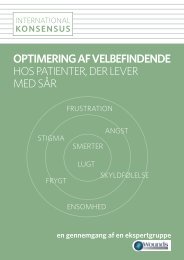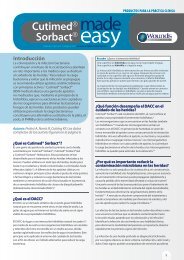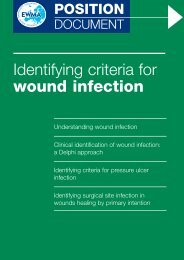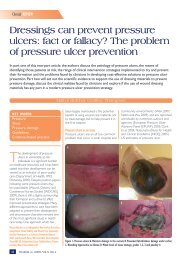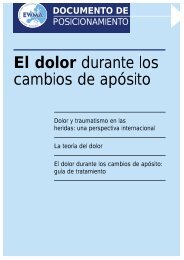leg ulcer management in patients with chronic oedema - Wounds ...
leg ulcer management in patients with chronic oedema - Wounds ...
leg ulcer management in patients with chronic oedema - Wounds ...
You also want an ePaper? Increase the reach of your titles
YUMPU automatically turns print PDFs into web optimized ePapers that Google loves.
ReviewFigure 8. Lymphorrhoea. (Courtesy of St.Giles Hospice).Figure 7. Hyperkeratosis and sk<strong>in</strong> creases (courtesy of St Giles Hospice).and <strong>oedema</strong>. Patients <strong>with</strong><strong>chronic</strong> <strong>oedema</strong> are at an<strong>in</strong>creased risk of <strong>in</strong>fection ifthe sk<strong>in</strong> is dry and cracked.This can lead to cellulitis andfurther deterioration <strong>in</strong> their<strong>oedema</strong>. The sk<strong>in</strong> <strong>in</strong>tegrity ofthe unaffected sk<strong>in</strong> must bema<strong>in</strong>ta<strong>in</strong>ed. Moisturisation ofthe sk<strong>in</strong> is essential to ma<strong>in</strong>ta<strong>in</strong>its hydration. An appropriatedress<strong>in</strong>g should be used toprotect the sk<strong>in</strong> around thewound (peri-wound) frommaceration (breakdown causedby moisture), which can occurif excess fluid (exudate) fromthe wound is left <strong>in</strong> contact<strong>with</strong> the sk<strong>in</strong>. Consultation<strong>with</strong> tissue viability specialistwill be of benefit <strong>in</strong> <strong>patients</strong><strong>with</strong> complicated <strong>ulcer</strong>s.Referral should be made ifthere is any doubt concern<strong>in</strong>g<strong>management</strong>.Compression and supportCompression and supportare the foundations of good<strong>oedema</strong> <strong>management</strong> and canbe used to reduce swell<strong>in</strong>gand ma<strong>in</strong>ta<strong>in</strong> the reduction(BLS, 2002). Often describedas conta<strong>in</strong>ment (Todd,2000), external support <strong>in</strong>comb<strong>in</strong>ation <strong>with</strong> muscularactivity stimulates both venousand lymphatic dra<strong>in</strong>age. MLLBis recognised as an essentialcomponent of the <strong>in</strong>tensivephase of lymph<strong>oedema</strong><strong>management</strong> (Casley-Smithand Casley-Smith, 1997).In addition to the reductionof <strong>oedema</strong>, MLLB restoreslimb shape, reduces the riskof sk<strong>in</strong> changes and canhelp to soften subcutaneoustissues and support stretchedsk<strong>in</strong> (Williams, 2003). MLLBenhances lymph formationby <strong>in</strong>creas<strong>in</strong>g movement of<strong>in</strong>terstitial fluid <strong>in</strong>to the <strong>in</strong>itiallymphatics by <strong>in</strong>creas<strong>in</strong>g tissuepressure when the patientmoves (Leduc et al, 1990;Thomas, 1996; Casley-Smithand Casley-Smith 1997).MLLB is <strong>in</strong>dicated for <strong>patients</strong><strong>with</strong>:8Fragile/damaged or <strong>ulcer</strong>atedsk<strong>in</strong>8Fibrotic sk<strong>in</strong> changes, e.g.hyperkeratosis, papillomatosis8Lymphangioma8Lymphorrhoea (Figure 8)8Solid, non-pitt<strong>in</strong>g, fibroticsubcutaneous tissues8Sk<strong>in</strong> folds/creases.MLLB is contra<strong>in</strong>dicated for<strong>patients</strong> <strong>with</strong>:8Acute <strong>in</strong>fection, e.g. cellulitis8Arterial <strong>in</strong>sufficiency8Deep ve<strong>in</strong> thrombosis (DVT)8Severe cardiac failure.Components of the MLLBsystem such as padd<strong>in</strong>g,toe bandag<strong>in</strong>g and full <strong>leg</strong>bandag<strong>in</strong>g may be <strong>in</strong>corporated<strong>in</strong>to venous bandag<strong>in</strong>g systems,as they may help to reduce the<strong>oedema</strong> thereby enhanc<strong>in</strong>gheal<strong>in</strong>g by improv<strong>in</strong>g deliveryof nutrients to the cells andspeed<strong>in</strong>g up the removal ofwaste products (Williamsand Keller, 2005). However,bandag<strong>in</strong>g the full <strong>leg</strong> doesrequire some skill and the fourlayersystem may not lend itselfreadily to this technique dueto the high rest<strong>in</strong>g pressuresexerted by the bandages at theknee jo<strong>in</strong>ts and thigh.Ideally, MLLB should bereapplied daily especially <strong>in</strong>the early stages of treatmentas the bandages may becomeloose or slip due to reduction<strong>in</strong> limb volume. However, asthe treatment cont<strong>in</strong>ues theuse of cohesive short-stretchbandages <strong>with</strong><strong>in</strong> the MLLBsystem can reduce slippage54 Wound Essentials • Volume 2 • 2007




